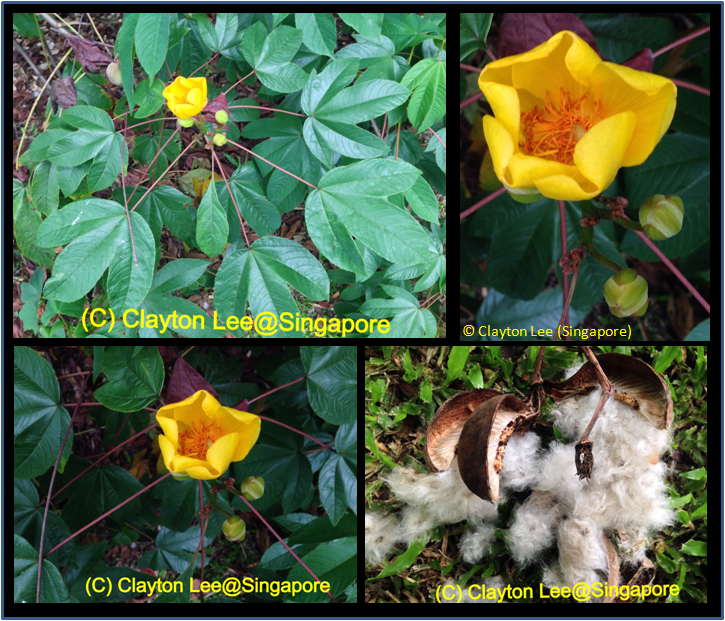Cochlospermum religiosum (L.) Alston, Handb. Fl. Ceylon 6(Suppl.): 14 (1931)
Species name meaning 'religious', referring to its religious importance or location near temples.Synonyms
Bombax conga Burm. f.
Bombax gossypium L. [Illegitimate]
Bombax lobatum Deschamps
Bombax religiosum L.
Cochlospermum balicum Boerl.
Cochlospermum gossypium DC. [Illegitimate]
Maximilianea gossypium Kuntze [Illegitimate]
Wittelsbachia gossypium Mart. & Zucc. [Illegitimate]
Diagnostics
It is a small tree growing upto 7.5 m. The bark is smooth and pale grey. It is sparsely clothed
with leaves and sheds them at the height of the flowering season. The leaves appear at the tips
of the branches and are palmately lobed. The flowers of the Buttercup tree are the most
conspicuous part of the tree. They are large, growing upto about 10 cm, buttercup shaped and
bright yellow. The stamens are orange. Fruits are capsules that are filled with hairy seeds, and
look like cotton when they open. [from www.flowersofindia.net]
Description
Small rather crooked-branched, more or less deciduous tree. Leaves cordate, 7.5-20 cm diam.,
margin undulate or obscurely crenate, apex of the lobes acuminate with blunt tip; petiole
articulated 8-25 cm long. Stipules linear-subulate, caducous, 7-8 mm long. Flowers in a simple
raceme or a loosely branched panicle, terminal, short-hairy, one flower open at a time on each
branch, facing side ways. Pedicels +/- 2 cm long. Bracts caducous, triangular-acute, short-hairy,
4.5 mm broad at the base. Corolla yellow, with a distinct odour. Sepals partly purplish,
2-2.5 by l-2.3 cm. Petals thickened at the base. Stamens slightly S-curved, unequal.
Anthers orange, falcate, 1 mm broad. Ovary globular. Style glabrous 1.5-2 cm. Capsule obovate,
5-7 cm long, valves striate-ribbed, 2.5-3 cm broad. Seeds reniform to cochleate, brown, 5-6 mm
across. [from Flora Malesiana]
Ecology
Occasionally found in deciduous forests of the lower slopes, in grassy areas and close to cliffs.
More or less established in Penang and very conspicuous in cultivated ground round the
town, near Dato Kramat growing in a native settlement, in Malacca Griffith noted 'near a stream
at the foot of... hill"; in N. Bali near a large pagode (Teysmann) pr. Singaradja. At Buitenzorg
[Bogor] flowering throughout the year. In Penang noted as deciduous. All specimens at low alt.
It is propagated by cuttings or rather loppings; any branch stuck in the ground will strike in
wet weather. Flowers last for 1.5 day. If the flower is setting fruit the withered petals remain
for a long time.
Uses
In India, and most of its current range, it is often used as a temple plant, and flowers are used
in offerings. This silky cotton is said to induce sleep when stuffed into pillows. Leaves are eaten
by the sambar dear. Bark is used for the preparation of medicines. The immature fruit is cut at the
top and inner material is removed. A flour of ragi and gram with jaggery is put inside the shell.
The opening is sealed with the cut piece. This is put into the fire and cooked. The cooked mixture
is given to cure tumours of the stomach.
Distribution
Native to India, Burma and Thailand, but introduced in many current or formerly hindu regions in
Southeast Asia, like Sri Lanka, Peninsular Malaysia, East Java and Bali.
Local names
Bali: Tjanigarah.
English: Buttercup tree, Yellow cotton-tree, Yellow silk cotton tree.
India: Galgal (Hindi), Ganeri (Marathi), Kattupparutti (Tamil), Kondagogu (Konkani),
Sonali simul (Bengali), Arasina buruga (Kannada), Cempanni (Malayalam), Konda gogu (Telugu).
Peninsular Malaysia: Bebaru.
